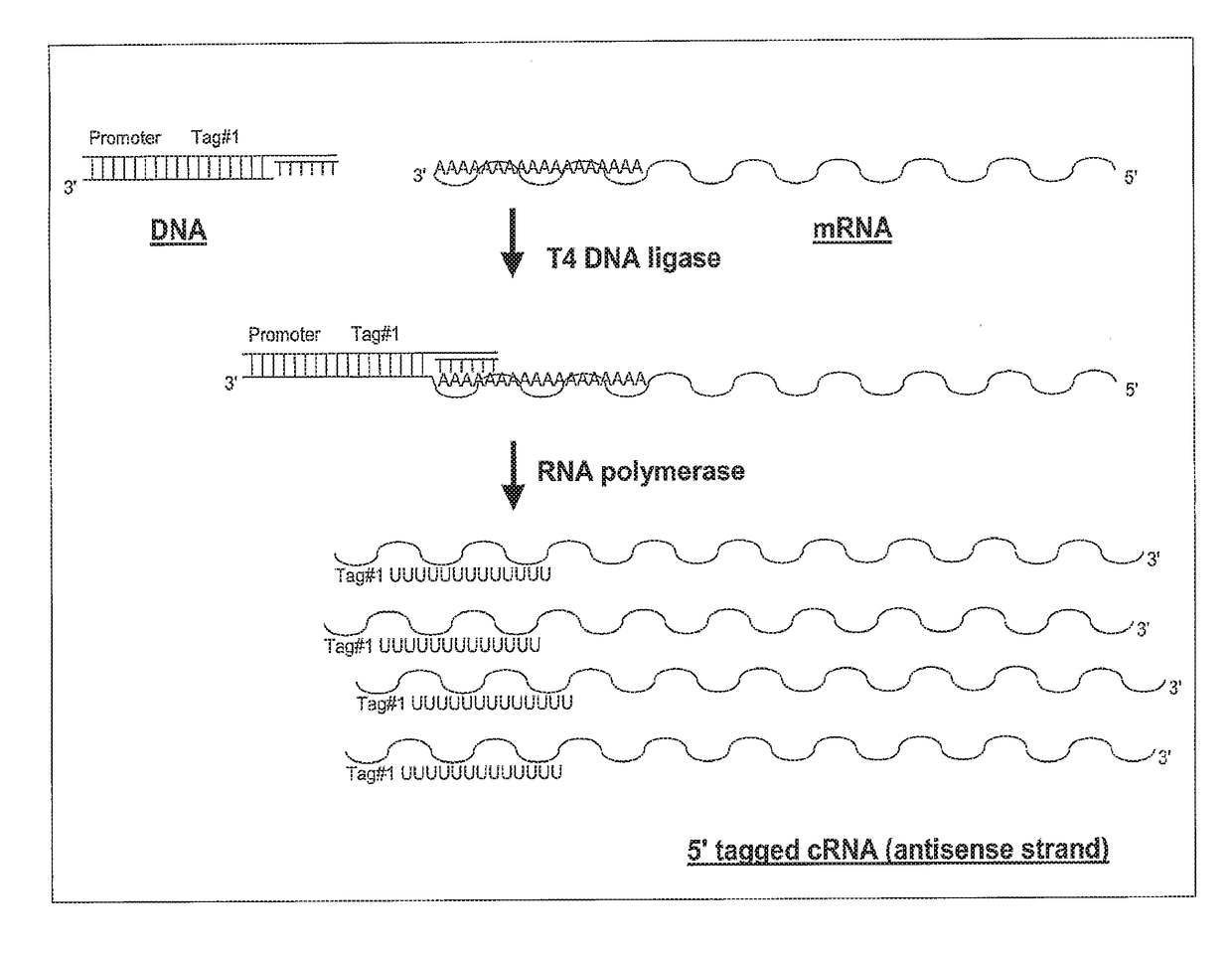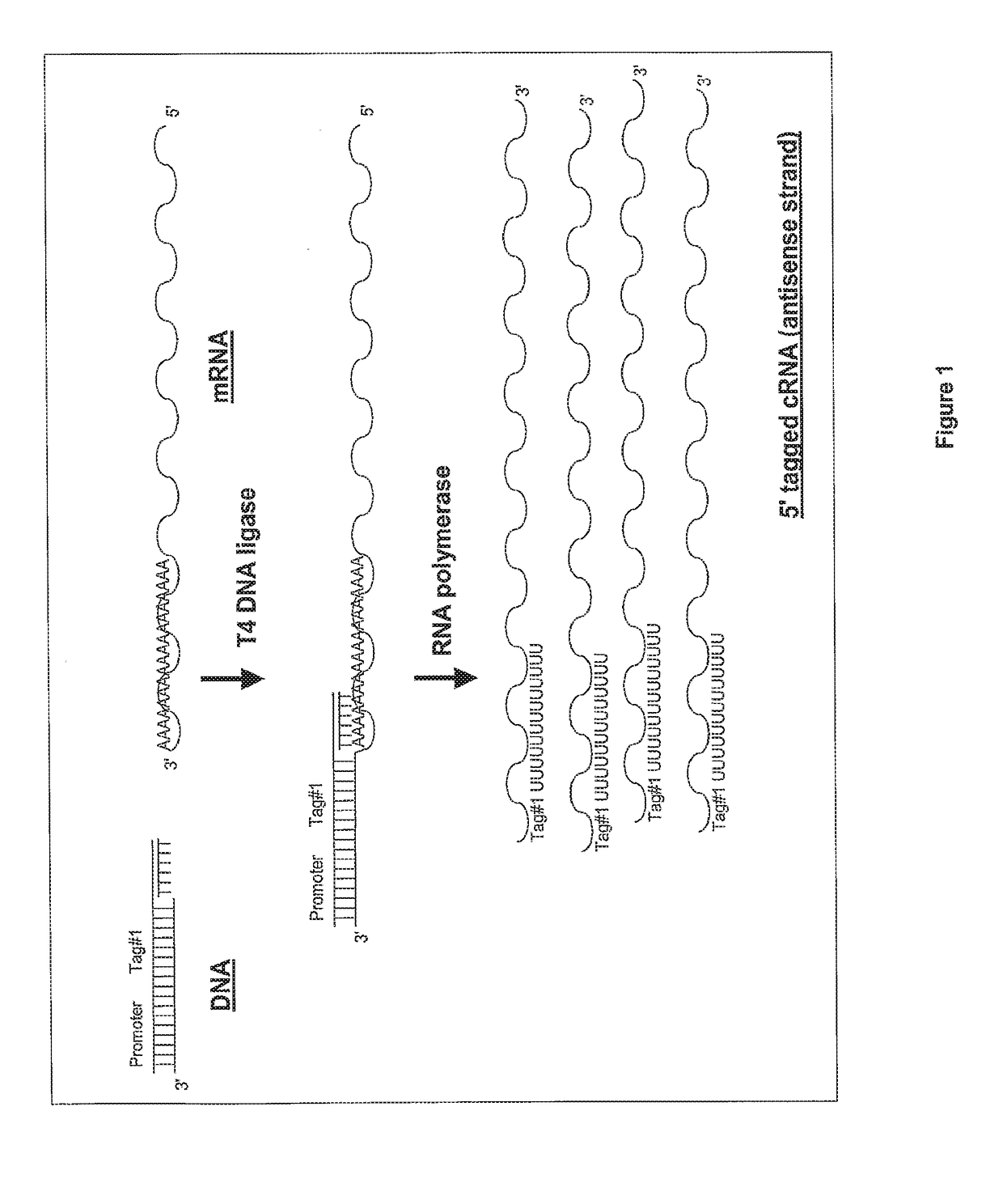Ligation-based RNA amplification
a ligation-based amplification and nucleic acid technology, applied in the field of new amplification, purification and detection methods of nucleic acids, can solve the problems of adding to the complexity and also cost of crna synthesis, dna ligase is much less effective at joining 3′-oh-terminated dna, and dna ligase is very inefficient at ligation of dna to rna strand
- Summary
- Abstract
- Description
- Claims
- Application Information
AI Technical Summary
Benefits of technology
Problems solved by technology
Method used
Image
Examples
example 1
Ligation of Double Stranded DNA to Synthetic RNA
[0153]All ligation reaction components except E. coli DNA Ligase (New England Biolabs; 10 units / μL) were mixed as indicated in Table 1. The reactions were heated at 60° C. for five minutes and allowed to cool to room temperature. E. coli DNA Ligase was added to the appropriate tubes and the reactions incubated at 30° C. for two hours. Each reaction was stopped by the addition of 1 μL RNase-free 0.5 M EDTA (US Biochemicals, Inc.).
TABLE 1Ligation reaction formulations for Example 1.IDComponent1234567Water (Ambion)16 μl 15 μl 16 μl 15 μl 14 μl 13 μl 15 μl 10X E. coli Ligase Buffer2 μl2 μl2 μl2 μl2 μl2 μl2 μlSUPERASE.IN ™(Ambion1 μl1 μl1 μl1 μl1 μl1 μl1 μl20 Units / μl)PT7IVS15 (15 pmol / μl)1 μl1 μl1 μlcPT7IVS15 (15 pmol / μl)1 μl1 μl1 μlRNA35 (16 pmol / μl)3 μl3 μlE. coli Ligase1 μl1 μl1 μlTotal Volume20 μl 20 μl 20 μl 20 μl 20 μl 20 μl 20 μl IDComponent89101112Water14 μl 12 μl 11 μl 15 μl 14 μl 10X E. coli Ligase Buffer2 μl2 μl2 μlSUPERASE.IN ™...
example 2
Three Different Ligases Will Ligate Double Stranded DNA to RNA
[0157]All ligation reaction components except the ligase enzymes were mixed as indicated in Table 2. The reactions were heated at 60° C. for five minutes and allowed to cool to room temperature. Different ligase enzymes were added to the appropriate tubes and the reactions incubated at 30° C. for two hours. Each reaction was stopped by the addition of 1 μl RNase-free 0.5 M EDTA (US Biochemicals, Inc.).
TABLE 2Ligation reaction formulations for Example 2. 10X ligation buffers were suppliedwith the enzymes.IDComponent12345678Water10 μl 9 μl12 μl 11 μl 12 μl 11 μl 13 μl 12 μl 10X E. coli Ligase Buffer2 μl2 μl10X T4 DNA Ligase2 μl2 μlBuffer10X T4 RNA Ligase2 μl2 μl2 μl2 μlBufferSUPERASE.IN ™1 μl1 μl1 μl1 μl1 μl1 μl1 μl1 μl(Ambion 20 Units / μl)5 mM NAD2 μl2 μlPT7IVS15 (15 pmol / μl)1 μl1 μl1 μl1 μl1 μl1 μlcPT7IVS15 (15 pmol / μl)1 μl1 μl1 μl1 μl1 μl1 μl1 μl1 μlRNA35 (16 pmol / μl)3 μl3 μl3 μl3 μl3 μl3 μl3 μl3 μlE. coli Ligase1 μl(NEBL...
example 3
Ligated RNA Can Be Transcribed
[0160]All ligation reaction components except E. coli DNA Ligase were mixed as indicated in Table 3. The reactions were heated at 60° C. for five minutes and allowed to cool to room temperature. E. coli DNA Ligase was added to the appropriate tubes and the reactions incubated at 16° C. for two hours. Each reaction was stopped by the addition of 1 μl RNase-free 0.5 M EDTA (US Biochemicals, Inc.).
TABLE 3Ligation reaction formulations for Example 3.Component↓ / ID→1234Water12 μl11 μl12 μl11 μl10X E.coli Ligase Buffer 2 μl 2 μl 2 μl 2 μlSUPERASE.IN ™ 1 μl 1 μl 1 μl 1 μlPT7IVS5 (15 pmol / μl) 1 μl 1 μl cPT7IVS5 (5 pmol / μl) 1 μl 1 μl PT7IVS15 (15 pmol / μl) 1 μl 1 μlcPT7IVS15 (5 pmol / μl) 1 μl 1 μlRNA35 (5 pmol / μl) 3 μl 3 μl 3 μl 3 μlE.coli Ligase 1 μl 1 μlTotal Volume20 μl20 μl20 μl20 μl
[0161]Five microliter samples of every reaction were mixed with 5 μl of Gel Loading Buffer II (Ambion) and heat denatured at 95° C. for two minutes. The entire amount of each...
PUM
| Property | Measurement | Unit |
|---|---|---|
| temperature | aaaaa | aaaaa |
| time | aaaaa | aaaaa |
| time | aaaaa | aaaaa |
Abstract
Description
Claims
Application Information
 Login to View More
Login to View More - R&D
- Intellectual Property
- Life Sciences
- Materials
- Tech Scout
- Unparalleled Data Quality
- Higher Quality Content
- 60% Fewer Hallucinations
Browse by: Latest US Patents, China's latest patents, Technical Efficacy Thesaurus, Application Domain, Technology Topic, Popular Technical Reports.
© 2025 PatSnap. All rights reserved.Legal|Privacy policy|Modern Slavery Act Transparency Statement|Sitemap|About US| Contact US: help@patsnap.com



